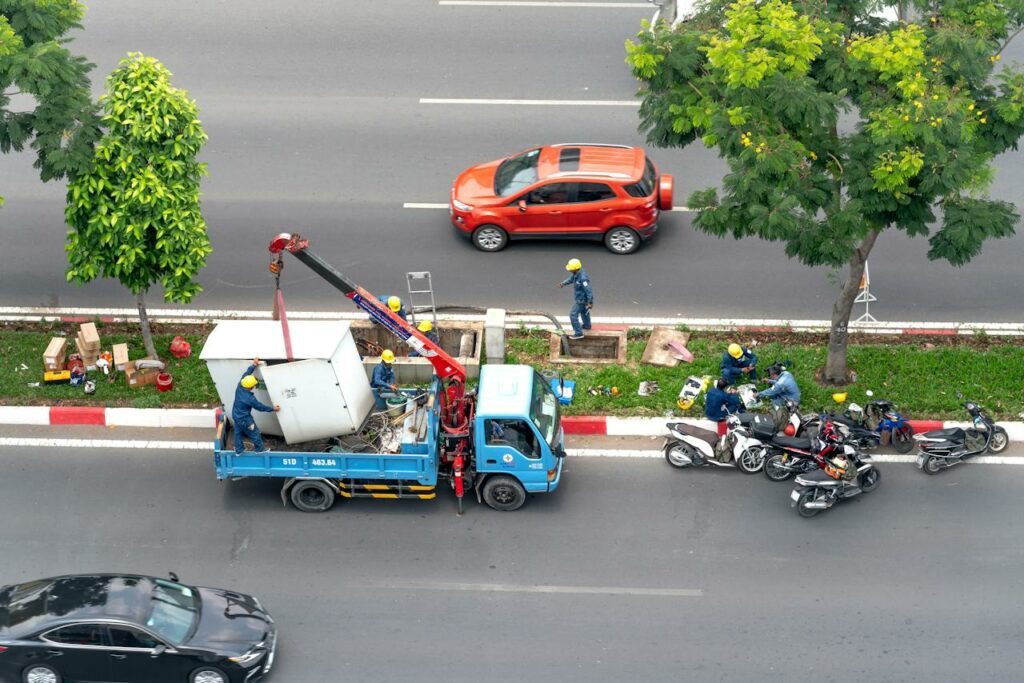1615 Mines Ave., Unit C Montebello Ca 90640
5 Cost Factors and Other Budgeting Tips for Heavy Equipment Hauling

When moving heavy equipment, it’s very important to be cautious because these machines are like big babies that need safe transport. You want them comfortable and secure on the road, like a seatbelt for a roller coaster. Equipment hauling keeps your heavy machines safe and sound, ready to work without a scratch or bump. It’s more than just a drive; it’s about getting your gear from point A to point B smoothly and securely, keeping your workhorse safe throughout the ride.
Moving big, heavy stuff isn’t easy or cheap! Heavy equipment hauling isn’t just about loading and driving – it’s like moving a small mountain. The costs pile up like a mountain too! From planning routes to truck capacity, every detail affects your budget. So, get ready to learn about managing your expenses and the critical factors that impact the cost of moving those hefty machines.
5 Cost Factors During Heavy Equipment Hauling:
Cost factors play a crucial role in heavy equipment hauling. Here are a few elements impacting the expenses:
Distance Traveled:
The distance the equipment needs to be moved is a key cost determinant. Longer distances generally mean higher expenses due to fuel, labor, and time. For example, transporting a forklift locally would cost less compared to shipping it cross-country.
Weight and Size of Equipment:
Heavier or larger equipment often incurs higher transportation costs due to specialized trailers and additional handling requirements. For instance, transporting a large excavator will cost more than moving a smaller machine like a skid-steer loader.
Permit Requirements:
Oversized equipment often needs special permits, adding to the overall cost. A crane or wide-load bulldozer may require escorts or specific permits for transport, leading to increased expenses.
Type of Transport:
Different modes of transport come with varying costs. For example, shipping via open transport trucks is more affordable than enclosed carriers and offers more protection but is pricier.
Equipment Preparation:
The cost can be affected by the time and effort required to prep the equipment for transportation. Ensuring proper cleaning, dismantling, and securing loose parts before transport might involve additional expenses.
Understanding these cost factors is vital in estimating the budget for heavy equipment hauling, ensuring a more accurate financial plan for the transportation process.

4 Budgeting Tips for Heavy Equipment Hauling:
Following are the budgeting tips that you seriously need to consider-
Advance Planning:
When planning heavy equipment hauling, getting a jump on things is key. Just like booking a flight well in advance can save money, planning the machinery transport early can help avoid rush costs. For instance, arranging the move during off-peak seasons or times of lower demand might result in better deals.
Get Multiple Quotes:
Requesting quotes from various moving companies is like comparing ticket prices from different airlines. You might receive different estimates for the same job; choosing the most cost-effective yet reliable option can help cut expenses. For instance, one company might charge extra for loading and unloading, while another includes these services in their package.
Consolidation:
Consolidating the shipment by transporting multiple machines in one haul is akin to fitting all your belongings into one moving truck. By moving various machines together, you might reduce costs compared to shipping them separately. For instance, shipping multiple pieces of equipment to the same location simultaneously may incur lower transportation expenses overall.
Consider Backhauling Opportunities:
Considering backhauling opportunities is akin to finding a way to earn some money on the way back from a trip. It involves finding cargo to transport on the return trip of the hauling truck. For instance, after delivering machinery to a specific location, the truck can search for goods or equipment to transport back, thus reducing the overall cost of the trip.
5 Tips to Evaluate Equipment Preparation:
When evaluating equipment preparation for heavy equipment hauling, there are crucial steps to ensure a smooth and safe transport:
Secure Loose Parts:
Before transporting heavy machinery, make sure all loose parts are secured. For instance, if moving a crane, ensuring that hooks, chains, or any detachable components are properly fastened prevents accidents on the road.
Cleaning and Inspection:
A clean machine is easier to inspect. Before transport, equipment should be thoroughly cleaned, as this will allow for a more accurate assessment. For example, cleaning a bulldozer thoroughly enables a detailed examination of any existing damage or potential issues.
Protect Fragile Parts:
Some machinery has delicate components that require extra care. Protecting these parts, such as sensitive electronic systems in excavators or forklifts, from potential damage during transportation is essential to avoid costly repairs later.
Fluid Management:
Fluids should be managed efficiently. For example, draining excess fluids such as fuel, oils, or coolants to a safe level can prevent spills and other hazards during transport.
Documentation and Labeling:
Clearly label equipment parts that have been disassembled. Maintaining proper documentation, especially with dismantled parts, ensures an easier reassembly process. For example, marking dismantled pieces of a crane with numbers will facilitate reassembly at the destination.
Effective equipment preparation significantly reduces the risk of damage during transit, ensuring a successful and safe hauling process.
5 Reasons to Hire Redline Machinery:
At Redline Machinery, we’re your go-to experts for hassle-free heavy equipment hauling! Here’s how we assist you:
Expert Guidance:
Our team provides detailed guidance and assistance throughout the hauling process, answering queries, and ensuring a smooth experience.
Tailored Solutions:
We tailor our services to your specific needs, ensuring your equipment is safely loaded, transported, and delivered to the designated location.
Safety Measures:
We prioritize safety! From secure loading to cautious transport, we ensure your equipment reaches its destination in prime condition.
Communication:
We believe in clear, consistent communication. Our team keeps you updated at every step, providing peace of mind about your equipment’s journey.
Reliability:
Count on us for reliability and timeliness. Your satisfaction is our priority, and we aim to exceed expectations with our services.
At Redline Machinery, we take pride in our services, offering comprehensive support to make heavy equipment hauling a stress-free process for our valued customers.
Conclusion:
We hope that the points mentioned in this article are informative enough for you to decide judiciously while you are planning heavy equipment hauling. It is important to consider the cost factors as well as the budgeting tips for the safe hauling of heavy equipment. Don’t ever allow the costs to pile up and be a burden for you!
FAQs:
How does the distance affect the cost of heavy equipment hauling?
The distance often directly impacts the overall cost. Longer transportation distances generally involve higher expenses due to increased fuel, labor, and time requirements.
What are the various permit requirements that could impact transportation expenses?
Oversized equipment often necessitates special permits. Equipment like cranes or wide-load bulldozers might require escorts or specific permits, leading to increased expenses.
How can backhauling opportunities help reduce the overall cost of equipment hauling?
Backhauling refers to finding cargo to transport on the return trip of the hauling truck. This helps offset costs, as the truck can earn money transporting goods back after delivering equipment.
What are the key tips to effectively evaluate and prepare equipment for transportation?
Properly securing loose parts, thorough cleaning and inspection, protecting fragile components, fluid management, and clear documentation are essential for safe and efficient equipment transport.


Related Post
25
Feb
5 Growing Effects of Automation in Machinery Transport and Logistics
Moving heavy equipment is a big deal. It's a task where you need to be strong, but also very careful....
15
Feb
7 Essential Tips for Moving Medical Equipment with a Moving Company
Moving medical equipment is like moving a collection of instruments that can save lives. More than just about moving stuff,...
25
Nov
7 Steps for Safe Heavy Machinery and Equipment Moving
Moving heavy machinery is a challenge many companies face, be it for relocation, expansion, or upgrading. This guide dives into...